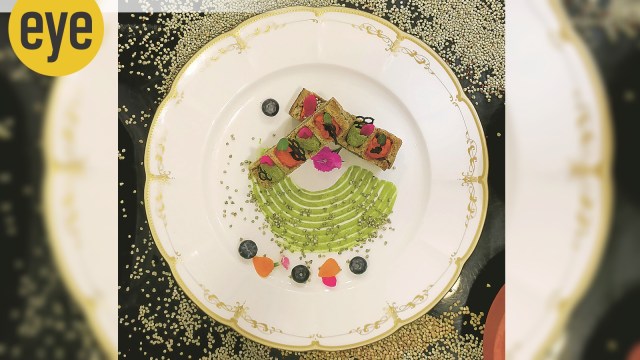When will the desi millet make it to the global platter?
As chefs turn up the heat on millet makeovers, it’s yet to find its culinary feet across geographies. Can we change years of habit and comfort with our other staples like rice and wheat?
 Bajra Millet Bhajji by chef Surinder Negi, Taj Palace, New Delhi (Credit: Taj Palace)
Bajra Millet Bhajji by chef Surinder Negi, Taj Palace, New Delhi (Credit: Taj Palace) Superchef and food consultant Sabyasachi Gorai was thinking up exotic dishes with quinoa as a member of the Quinoa Council of India in 2010 when his mind drifted. Having been entrusted with the job of popularising this South American staple in India, his senses wafted back to familiar smells from his grandmother’s kitchen in the old miners’ town of Asansol in Bengal. That’s where everybody had the kaon chaal or kaon millets, in either pulao or kheer, for breakfast. It was filling enough to get by a heavy work day and nutty and grainy enough to taste like the quinoa. “That’s when I decided that I would do something similar for millets. Much before the millet mission happened,” he says, rolling a fish finger in his favourite millet instead of breadcrumbs, dunking it in oil and laying it almost instantaneously in a soaking paper, all crunchy and fluffed up on the outside, moist and melting on the inside, the fishy flavour sassed up by the grainy wrap.
Although the Central government is pushing millets and the UN, too, has declared 2023 the International Year of the Millets, chef Saby has been working on a millet makeover for a while. At his outlet in Bengaluru, a group of youngsters are savouring his ragi taco, barnyard millet kibbeh and millet prawn dimsum. The taco with chicken was inspired by the Mandua puri, which is ragi puri with local chicken curry, drawn from a travel memory he had in Uttarakhand.
Yet, for all the boutique revivalist efforts, awareness campaigns on their health benefits, climate-resilience and water efficiency and celebrity endorsements, millets are yet to augment a superfood revolution that Prime Minister Narendra Modi had hoped for. Even though he teamed up with Grammy Award-winning, Indian-American musician Falguni Shah to create a sloganeering song Abundance in Millets, they are still a far cry from being on our tables. Can we change years of habit and comfort with our other staples like rice and wheat?
Millets were our first domesticated staple in India, says food historian Pushpesh Pant. “It was common during the Indus Valley civilisation and is mentioned in Vedic texts, but its familiarity is now confined to the Deccan region,” he says. A report earlier this year, titled “Assessing Consumer Demand for Millets in India”, by the Development Intelligence Unit (DIU) found that about two-thirds of respondents in both urban and rural areas have consumed millets at some point, while 14 per cent were not even aware of them. Central India is lower on millet consumption (52 per cent) despite awareness. Also, the pattern of consumption sees a rural-urban divide, an age divide, and a zonal divide, with more consumers in the south than in the north. What then is holding millets back from being ubiquitous in our kitchens? “The reason millets are not transcending geographies and becoming a global food culture is the lack of smart packaging. Some corporates are now stepping in but we need to work on the flavour profile, seasonings and smart-sell them as everyday convenience food,” says Sandeep Ghosh, senior fellow and director at DIU.
But chef Saby, who has seen how quinoa has landed on our plates within 10 years from the first Aahar Mela he curated, says the rice and wheat fixation that came with the Green Revolution would naturally take some time to overturn. “Extricating millennial memory of our ancestral food won’t happen in a year despite the National Millet Mission. We have to give it time,” says he.
Before the Green Revolution, millets made up around 40 per cent of all cultivated grains, which has now fallen to around 20 per cent. There has been a decline in the area for millet cultivation since 1968, says an India Insight report. Despite the government nomenclature of millets as ‘Shree Anna’, they are just five to six per cent of the national food basket. The yield is lower compared to rice, there is not enough integrated value-chain interventions and an assured procurement system for farmers yet. Above everything else, millets are highly perishable compared to rice and wheat. And they are definitely not aspirational like eating rice and wheat was in the ’60s. The coarse millets were considered the cheap option for the rural poor, primarily because they could be grown anywhere.
But Dayakar Rao, principal scientist and CEO Nutrihub, ICAR-Indian Institute of Millets Research, Hyderabad, is working to make millets kitchen-friendly and palate-ready. “In a country burdened with heart disease and diabetes, we are packaging traditional millets and grains with a high nutritional profile as a lifestyle-management tool that reduces dependence on carbohydrate-heavy rice and wheat. With the help of corporates, we have developed a collectivisation model to help farmers, who can roll out millet ranges with their mainstream brands,” he says. Now, there’s a wide range of products from millet cookies, flours, pastas, noodles to even milk.
Rao is working the pyramid ground up. “We are now hand-holding startups and helping tribal groups with technical know-how on quality, processing and branding. We are emphasising millets as organic produce, using biofertilisers and providing subsidies for them,” he adds. Of course, he faces the heat on whether corporates interested in profits will compromise standards, mass-produce millets like any other cereal and rob them of the mantle of a health superfood that everybody needs. “There will always be scepticism. Even 50 years ago, did people imagine that wheat would be a staple in Kerala? The millet journey has just started. Many nutrition experts are worried about the food value going down because of processing. But we are keeping millets minimally polished and processed, not ultra processed. There is still a lot of nutritional value left and that’s better than any rice, wheat or cereals. The smaller millets do not need to be polished at all. They are less acidic,” he says.
At a time when India’s disease burden is increasing, driven by hypertension, diabetes and obesity, millets, undoubtedly, are challenging old habits ingrained by food majors that have made us dependent on our carb-heavy breakfast cereal or the comforting pasta. That’s why millets have been branded as “nutri cereals”. Their carbohydrate content (78 per cent) is almost equal to that of rice (82 per cent) and wheat (76 per cent). However, they score over rice and wheat because they are rich in complex carbohydrates, fibre, protein, antioxidants, B vitamins and micronutrients. “All of these add heft to the meal, keep you full longer, slow down food breakdown and prevent blood sugar spikes. And that counts big among Indians who have a big burden of diabetes and cardiovascular diseases. Millets are naturally gluten-free and have a low glycemic index (GI), which means they have a slower impact on blood sugar levels,” says Dr Ambrish Mithal, chairman of endocrinology and diabetes at Max Healthcare. Besides, millets really make use of your molars, forcing you to chew and grind them, which is good for gut health, than just swallowing cereals down.
A lot of the scepticism about millets also comes from their anti-nutritive properties like phytic acid, which hinders absorption of nutrients. “But all you need to do is soak them for eight to 10 hours. Throw away the water and the prep time is the same as rice. Fermentation with curd helps. Remember children were once given barley water as a weaning food,” says Dr Seema Gulati, National Diabetes, Obesity and Cholesterol Foundation (NDOC) Centre for Nutrition Research.
The roti substitution has taken off with Bollywood celebrities like Kiara Advani, Bhumi Pednekar and Shilpa Shetty sharing their meal plans with ragi rotis on social media handles. Most food experiments in cities are incorporating millets as part of the Western breakfast staples of a porridge, topped with fruits, nuts and honey, breads, muffins and pancakes. Some may just sprinkle roasted millet grains on salads, use them as a crunchy topping for yogurt or lend a heartier texture to soups and stews. “This way,” says Bengaluru-based nutritionist Priyanka Rohatgi, “you can get a Mediterranean-style diet. Did you know that millets with legumes like lentils, chickpeas or beans are a complete protein source that rivals meat? Pair them with a colourful array of vegetables to enhance the vitamin and mineral content of your meals. Use herbs and spices to enhance flavours without relying on excessive salt or unhealthy fats.”
However, for chef Surinder Negi, executive sous chef, Taj Palace, who helmed the millet spread for foreign guests at the G-20 summit in New Delhi, the grains should play to their strengths. He recreated his grandmother’s millet fritters, just the way he remembers them from his village. His bajra flour samosas with a sweet nutty flavour were an instant hit with guests as was the ragi idli. But it was the millet waffle with a finely-diced vegetable mix that delegates wanted repeat orders of. Be it amaranth jalebis or pearl millet peas soup, Negi says that “the only way to popularise millets is to present traditional and familiar food using them.” He swears by amaranth and foxtail millets as the easiest to prepare. “Our millet range is diverse enough to have depth of flavour, complexity and texture. Just adjust the seasoning and source the right millet base for the right dish,” he says.
Chef Saby says there was a huge variety of millets and much more developed tastemakers and flavourants during the Indus Valley Civilisation. “While we used fermented sauces and herbs, generations of disconnectedness and relegation as the poor man’s food have made millets look somewhat leaden and bland. But they have their own feel and flavour that’s better than the long-grained basmati rice which has zero flavour but absorbs all other flavours readily, creating a perception of being an elegant obsession,” he says.
Our tastebuds are not used to a millet’s own rich and diverse flavour profile and texture. Each grain absorbs water differently, is malleable and can be easily adaptable to any recipe. That’s why chef Saby now teams up millets with seafood and chicken. And there’s always the good old millet craft beer, with toffee and biscuit notes, to wash it all down with, thanks to the Pune-based brewery, Great State Aleworks. A toast to that!
RECIPE
FROM CHEF SABY’S TABLE
 Sorgum Prawn Dumpling
Sorgum Prawn Dumpling
Succulent prawn wrapped in kale with soy dipping sauce
Ingredients:
FOR WRAPPING
- Fresh kale 12 leaves
FOR FILLING
- Prawns (peeled, deveined) 120 gm
- Sorghum (boiled) 120 gm
- Garlic (chopped) 10 gm
- Soya sauce 15 ml
- Ginger (chopped) 15 gm
- Oil 40 gm
- Salt To taste
FOR SAUCE
- Soya 60 ml
- Chilli paste 20g
- Honey 10 ml
- Toasted sesame 5 gm
FOR PRAWN MARINATION
- Ginger garlic paste 6 tbsp
- Soy 10 gm
- Lemon juice 10 ml
Method:
Prawn marination
- Marinate the prawns with ginger garlic paste, lemon juice and soy sauce Barnyard millet filling
- Boil the sorghum with salt until cooked
- Heat oil. Add chopped ginger, garlic and soy sauce
- Add cooked millet and toss until mixed
- Adjust the seasoning
For sauce
- In a mixing bowl, take soy sauce, honey and chili paste
- Whisk in everything together and add toasted sesame
- Adjust seasoning
To assemble
- Wash and clean the kale leaves
- Take a prawn and wrap it with cooked millets. Then firmly wrap it with kale leaf, with the tail visible
- Put the dumplings in a steamer and steam for around 5 minutes till the prawns are cooked with a beautiful coral colour
- Serve it with the soy dipping sauce
Photos





- 01
- 02
- 03
- 04
- 05


























